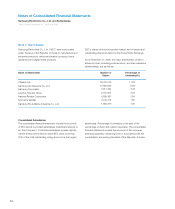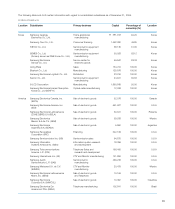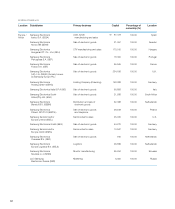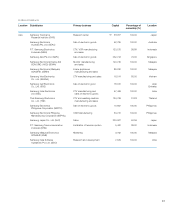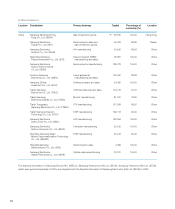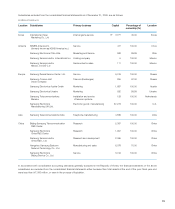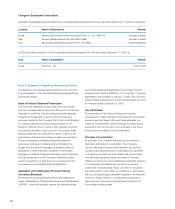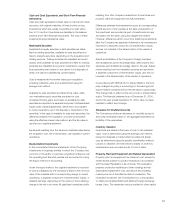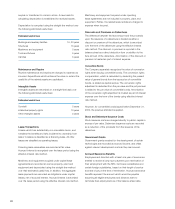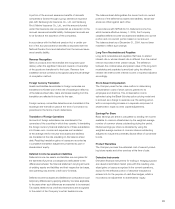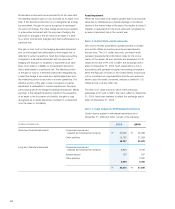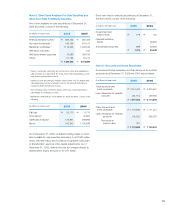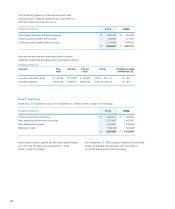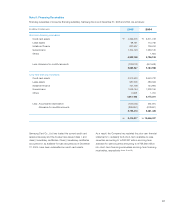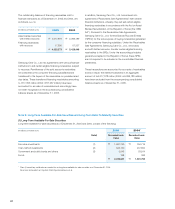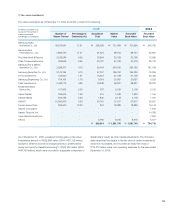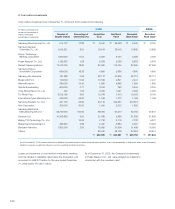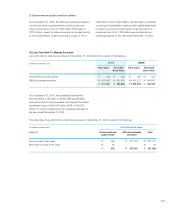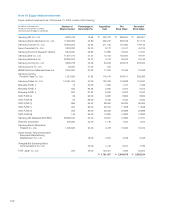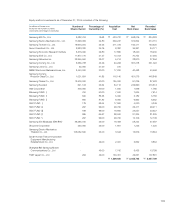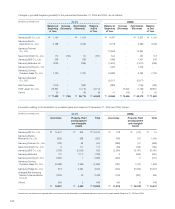Samsung 2005 Annual Report Download - page 96
Download and view the complete annual report
Please find page 96 of the 2005 Samsung annual report below. You can navigate through the pages in the report by either clicking on the pages listed below, or by using the keyword search tool below to find specific information within the annual report.
94
All derivative instruments are accounted for at fair value with
the resulting valuation gain or loss recorded as an asset or lia-
bility. If the derivative instrument is not designated as a hedg-
ing instrument, the gain or loss is recognized in earnings in
the period of change. Fair value hedge accounting is applied
to a derivative instrument with the purpose of hedging the
exposure to changes in the fair value of an asset or a liabil-
ity or a firm commitment (hedged item) that is attributable to a
particular risk.
The gain or loss, both on the hedging derivative instrument
and on the hedged item attributable to the hedged risk, is
reflected in current operations. Cash flow hedge accounting
is applied to a derivative instrument with the purpose of
hedging the exposure to variability in expected future cash
flows of an asset or a liability or a forecasted transaction
that is attributable to a particular risk. The effective portion
of the gain or loss on a derivative instrument designated as
a cash flow hedge is recorded as a capital adjustment and
the ineffective portion is recorded in current operations. The
effective portion of the gain or loss recorded as a capital
adjustment is reclassified to current operations in the same
period during which the hedged forecasted transaction affects
earnings. If the hedged transaction results in the acquisition
of an asset or the incurrence of a liability, the gain or loss
recognized as a capital adjustment is added to or deducted
from the asset or the liability.
Asset Impairment
When the book value of an asset is greater than its recoverable
value due to obsolescence, physical damage or the abrupt
decline in the market value of the asset, the decline in value, if
material, is deducted from the book value and recognized as
an asset impairment loss in the current year.
Note 3: United States dollar Amounts
SEC and its Korean subsidiaries operate primarily in Korean
won and its official accounting records are maintained in
Korean won. The U.S. dollar amounts, provided herein,
represent supplementary information solely for the conve-
nience of the reader. All won amounts are expressed in U.S.
dollars at the rate of \1,013 to US$1, the exchange rate in
effect on December 31, 2005. Such presentation is not in
accordance with generally accepted accounting principles in
either the Republic of Korea or the United States, and should
not be construed as a representation that the won amounts
shown could be readily converted, realized or settled in U.S.
dollars at this or at any other rate.
The 2004 U.S. dollar amounts, which were previously
expressed at \1,043 to US$1, the rate in effect on December
31, 2004, have been restated to reflect the exchange rate in
effect on December 31, 2005.
Note 4: Cash Subject to Withdrawal Restrictions
Cash in banks subject to withdrawal restrictions as of
December 31, 2005 and 2004, consist of the following:
(in millions of Korean won) 2005 2004
Short-term financial instruments Government-sponsored
research and development projects \ 33,525 \ 25,066
Other activities 15,732 37,563
49,257 62,629
Long-term financial instruments Government-sponsored
research and development projects 8,826 3,019
Special deposit 133 247
Other activities - 2,000
8,959 5,266
\58,216 \67,895


